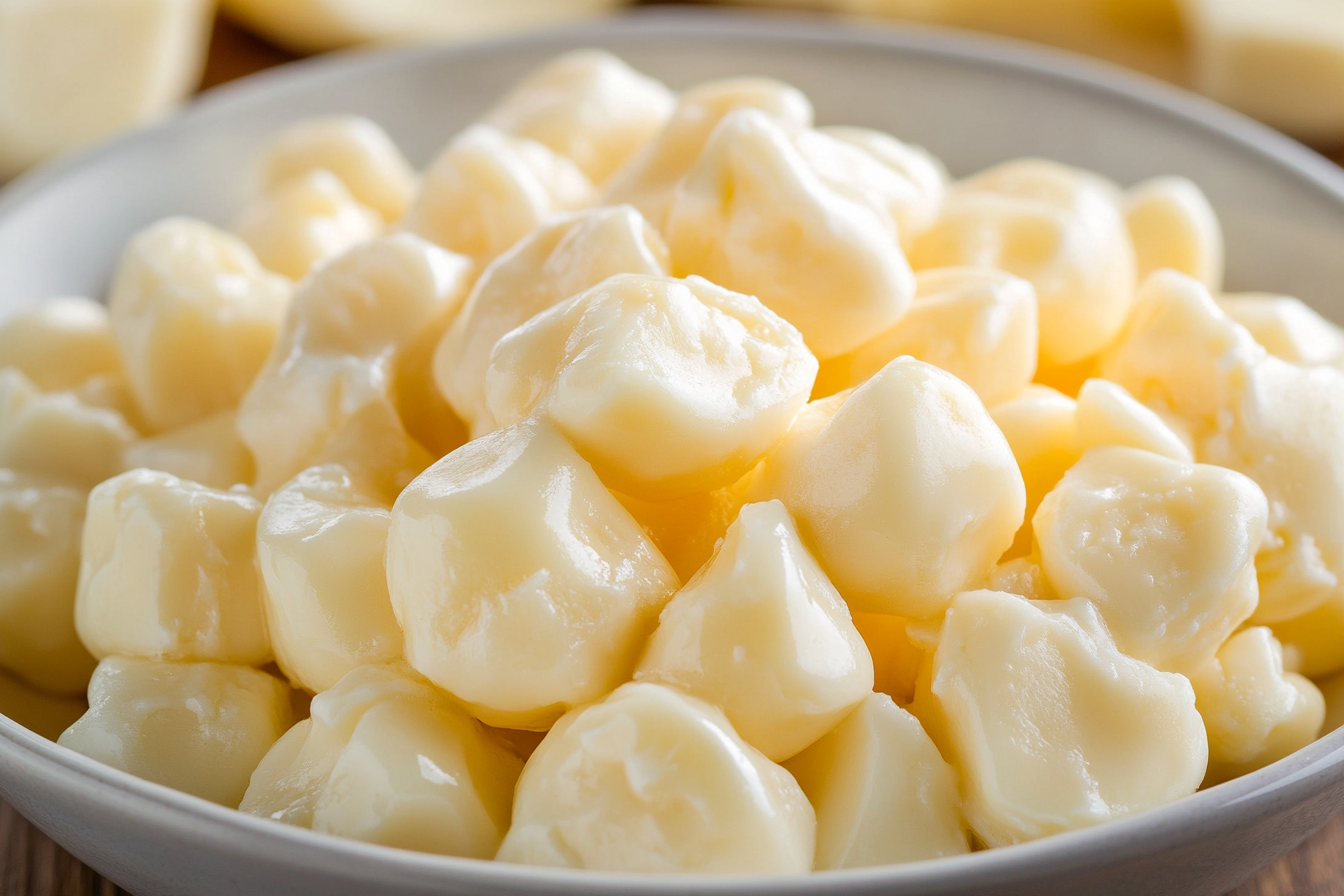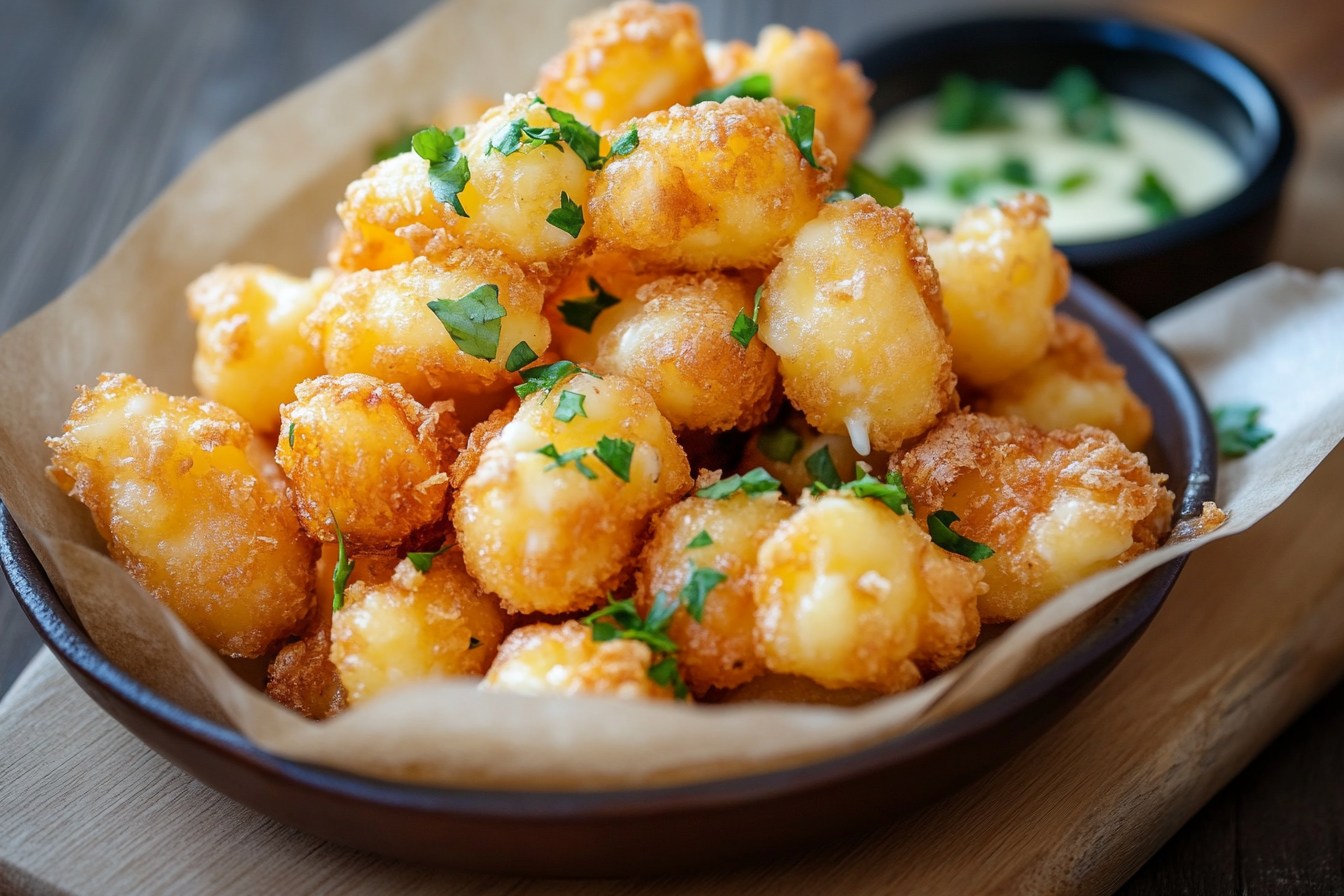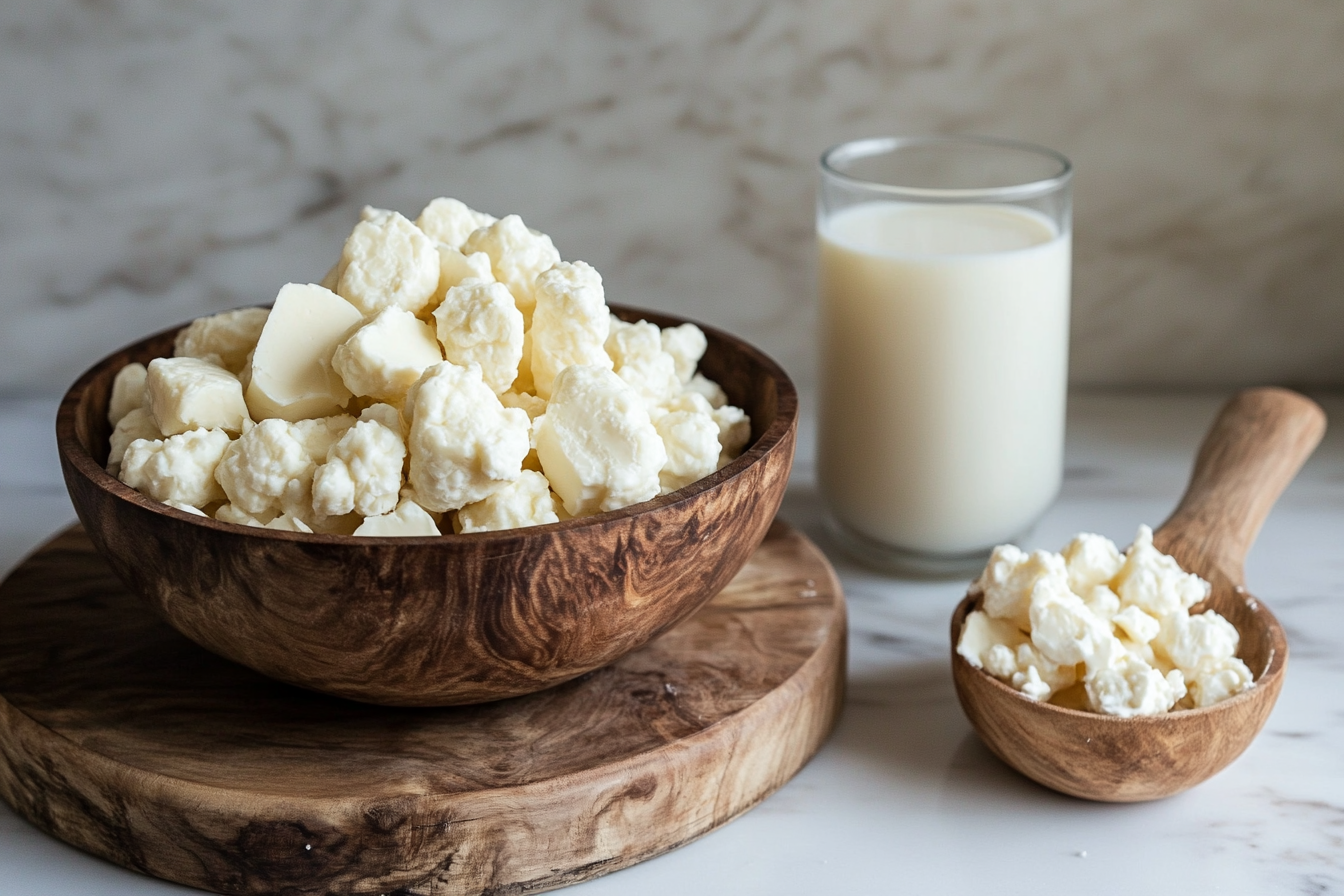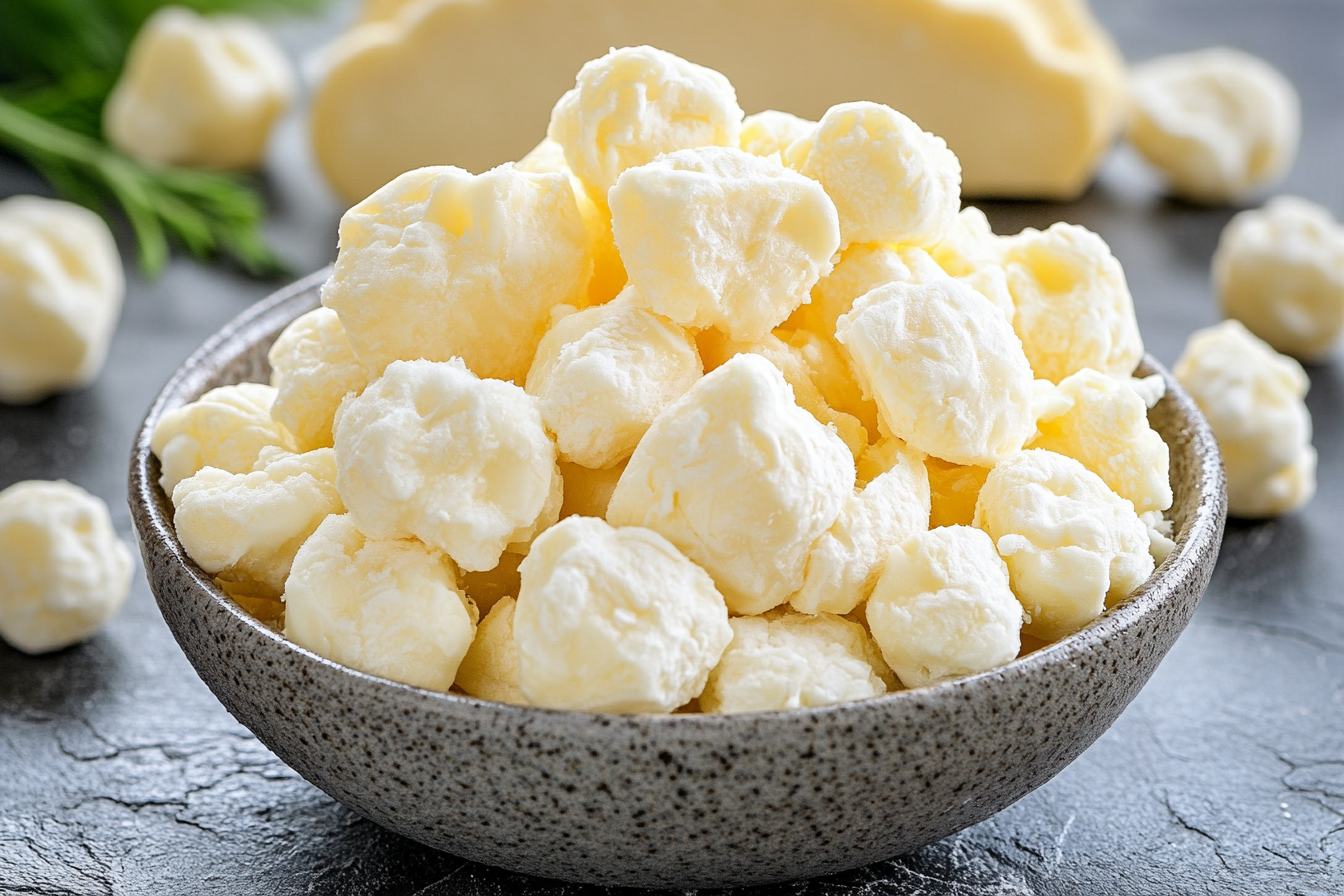Cheese curds are a delightful and unique dairy product that many people have enjoyed, particularly in regions like Wisconsin and Canada. If you’re new to the world of cheese curds, you might be wondering: Can you eat cheese curds raw? This comprehensive guide will explore everything you need to know about cheese curds, their nutritional value, and the best ways to enjoy them, ensuring that you have all the information you need to savor this dairy delicacy.
What Are Cheese Curds?

Cheese curds are the fresh curds of cheese, often associated with the early stages of cheddar cheese making. These small, solid pieces of curdled milk have a mild flavor and a unique, springy texture that makes them distinct from regular cheese.
How Cheese Curds Are Made
Cheese curds are produced during the cheese-making process when the curds separate from the whey. These curds are then cut, drained, and ready to eat. The process involves:
- Coagulation: Milk is curdled using rennet or an acidic substance, causing the milk solids (curds) to separate from the liquid (whey).
- Cutting: The curds are cut into smaller pieces, which helps expel more whey.
- Cooking: The curds are gently cooked to firm them up.
- Draining: The whey is drained away, leaving the curds behind.
- Salting: The curds are salted to enhance flavor and help with preservation.
The freshness of cheese curds is what gives them their characteristic “squeak” when bitten into. This squeak is caused by the elastic protein structure within the curds, which rubs against your teeth as you chew.
For more detailed information on how to use cheese curds in various recipes, check out Cheese Curds Recipes, where you’ll find numerous delicious ways to enjoy this dairy treat.
Freshness is Key
Freshness is crucial for the best taste and texture. Fresh cheese curds are often sold on the same day they are made. Unlike aged cheeses, which develop complex flavors over time, cheese curds are best enjoyed as fresh as possible. The fresher the curds, the more pronounced the squeak.
Why Are Cheese Curds Popular?

Cheese curds are beloved for their unique combination of taste and texture. Their mild flavor makes them versatile enough to be used in various dishes, while their texture offers a satisfying chew that many people enjoy. In regions like Wisconsin, cheese curds are a staple, often enjoyed as a snack or incorporated into local dishes.
Can You Eat Cheese Curds Raw?
Can you eat cheese curds raw? The short answer is: Yes, you can eat cheese curds raw. In fact, this is how they are most commonly consumed. Eating them raw preserves their fresh flavor and unique texture, making them a popular snack.
Pros of Eating Cheese Curds Raw
- Flavor: Raw cheese curds have a mild, milky flavor that is less intense than aged cheese. This makes them appealing to those who prefer a subtle, fresh taste.
- Texture: The characteristic “squeak” when you bite into fresh cheese curds is a sign of their freshness. This squeakiness is part of what makes raw cheese curds so enjoyable to eat.
- Nutritional Benefits: Eating raw cheese curds means you’re getting all the nutrients without any added ingredients or cooking processes that might diminish their value. Raw cheese curds retain all their natural vitamins, minerals, and proteins.
Cons of Eating Cheese Curds Raw
- Safety Considerations: Like any dairy product, there are considerations around pasteurization. Make sure the cheese curds are from a reliable source, especially if they’re made from raw milk. Pasteurized cheese curds are generally safer and still offer the same delightful experience.
- Short Shelf Life: Fresh cheese curds have a relatively short shelf life. They are best consumed within a few days of being made, as they lose their characteristic squeak and freshness over time.
Health Risks of Raw Milk Cheese Curds

If the cheese curds are made from raw (unpasteurized) milk, there is a slight risk of bacterial contamination, such as Listeria or E. coli. It’s crucial to ensure that raw milk cheese curds come from a reputable source that follows strict hygiene practices. However, most commercially available cheese curds are made from pasteurized milk, which reduces these risks significantly.
To learn more about the nutritional content and safety of eating raw cheese curds, you can refer to this comprehensive guide on Cheese Curds Nutrition.
Nutritional Profile of Cheese Curds
When it comes to nutrition, cheese curds pack a punch. They are a great source of several essential nutrients that contribute to a balanced diet.
Caloric Content
Cheese curds are relatively high in calories, with about 110 calories per ounce. While they are calorie-dense, they also provide a significant amount of nutrients, making them a satisfying snack option.
Protein
Cheese curds are a good source of protein, offering about 6 grams per ounce. Protein is essential for building and repairing tissues, making cheese curds an excellent choice for a post-workout snack or part of a balanced meal.
Fat Content
Cheese curds are high in fat, including saturated fat, which is something to be mindful of if you’re watching your intake. However, fat is also an essential nutrient, providing energy and supporting cell function. The fat in cheese curds helps make them a satisfying and energy-dense snack.
Calcium and Other Minerals
Like most dairy products, cheese curds are an excellent source of calcium, supporting bone health. They also provide other essential minerals such as phosphorus, which is important for maintaining strong bones and teeth.
Vitamins
Cheese curds contain vitamins such as vitamin A, which is important for eye health, and vitamin D, which helps the body absorb calcium. These vitamins contribute to the overall nutritional value of cheese curds, making them a beneficial addition to your diet.
Understanding the nutritional content of cheese curds can help you make informed choices about including them in your diet. For example, they make a great snack that’s both satisfying and nutritious, especially when enjoyed fresh.
If you are curious about other versatile dairy products, this article provides insights into what you can do with cottage cheese, a close relative of cheese curds.
Taste and Texture of Raw Cheese Curds
The taste and texture of raw cheese curds are what set them apart:
- Taste: They have a mild, slightly tangy flavor that is much fresher than aged cheese. This fresh taste is a favorite among cheese lovers who appreciate the simplicity and purity of raw dairy products. The flavor can vary slightly depending on the type of milk used and the specific cheese-making process.
- Texture: The texture is springy and slightly rubbery, which is why they are often described as squeaky when bitten into. The squeakiness is an indicator of the curd’s freshness, a quality that diminishes over time. As cheese curds age, they become softer and lose their squeak.
Why Do Cheese Curds Squeak?
The squeak of fresh cheese curds is due to the elastic protein structure within the curds. When you bite into a fresh curd, the protein strands rub against your teeth, creating a squeaky sound. This squeakiness is one of the hallmarks of high-quality, fresh cheese curds.
The unique combination of taste and texture makes raw cheese curds a delightful snack that can be enjoyed on its own or incorporated into various dishes.
Different Ways to Enjoy Cheese Curds Raw

While eating them raw is a popular choice, there are many other ways to enjoy cheese curds:
Fried Cheese Curds
Fried cheese curds are a popular snack where cheese curds are battered and fried until golden brown. This method of preparation adds a crispy exterior while maintaining the soft, squeaky interior of the curds. Fried cheese curds are often served with dipping sauces, such as ranch or marinara, and are a favorite at fairs and festivals.
- Recipe Tip: If you want to make fried cheese curds at home, consider using a light batter to let the flavor of the curds shine through. For a healthier option, you can bake the curds instead of frying them.
Cheese Curds in Poutine
Poutine is a Canadian dish where cheese curds are served over french fries and smothered in gravy. This is perhaps the most famous use of cheese curds outside of eating them raw. The hot gravy slightly melts the cheese curds, creating a gooey, delicious topping for the crispy fries.
- Recipe Tip: When making poutine, it’s essential to use fresh cheese curds to ensure they retain their squeak even when covered in hot gravy. You can find more ideas for loaded fries in Loaded Fries Recipes and Ideas, where cheese curds can be a perfect addition.
Cheese Curds in Salads
Cheese curds can also be a great addition to salads, providing a creamy texture and mild flavor that pairs well with fresh greens and vegetables. They work particularly well in salads that include crunchy elements like nuts or croutons, as the squeakiness of the curds adds an extra layer of texture.
- Recipe Tip: Try adding cheese curds to a simple green salad with a light vinaigrette. The acidity of the dressing will complement the mild flavor of the curds, making for a refreshing and satisfying dish.
Cheese Curds in Soups and Stews
Cheese curds can be added to soups and stews as a unique topping. They provide a creamy, slightly tangy flavor that can enhance the richness of the dish. The curds will soften slightly in the hot soup but will not melt entirely, giving you a delightful texture in each bite.
- Recipe Tip: Add cheese curds to a hearty vegetable or beef stew just before serving. The curds will add a creamy texture without overpowering the other flavors in the dish.
Pairing Cheese Curds with Drinks
Cheese curds pair well with a variety of beverages, including non-alcoholic options like sparkling water, apple cider, and herbal teas. They also make a great addition to a cheese platter served with fresh fruits and nuts.
- Pairing Tip: For a refreshing combination, pair cheese curds with a crisp apple cider. The sweetness of the cider complements the mild flavor of the curds, creating a balanced and enjoyable snack.
For those looking to get creative in the kitchen, you can explore more ideas in Loaded Fries Recipes and Ideas, which provides inspiration for dishes that could easily incorporate cheese curds.
Frequently Asked Questions
What is the Best Way to Store Cheese Curds?
To maintain their freshness, cheese curds should be stored in the refrigerator in an airtight container. They are best consumed within a few days of purchase, though they can be frozen for longer storage.
- Storage Tip: If you need to store cheese curds for an extended period, consider freezing them. Place the curds in a single layer on a baking sheet and freeze them before transferring them to a freezer-safe bag. This method helps prevent the curds from sticking together.
How Long Do Cheese Curds Stay Fresh?
Cheese curds are best eaten within 24 hours of being made to enjoy their optimal taste and texture. However, they can remain fresh for up to a week if properly stored.
- Freshness Tip: To extend the freshness of cheese curds, keep them in the coldest part of your refrigerator. You can also refresh the curds by soaking them in cold water for a few minutes before eating.
Are There Any Health Risks Associated with Eating Raw Cheese Curds?
If the cheese curds are made from pasteurized milk, the health risks are minimal. However, if they’re made from raw milk, there is a slight risk of bacterial contamination, so it’s essential to ensure they’re from a reputable source.
- Safety Tip: Always check the label to see if the curds are made from pasteurized milk, especially if you’re serving them to children, pregnant women, or anyone with a weakened immune system.
Can You Freeze Cheese Curds?
Yes, cheese curds can be frozen to extend their shelf life. However, freezing may alter their texture, making them less squeaky when thawed.
- Freezing Tip: To maintain the best possible texture, thaw frozen cheese curds in the refrigerator rather than at room temperature. This slow thawing process helps preserve their texture.
Why Do Cheese Curds Squeak?
The squeak of fresh cheese curds is due to the elasticity of the protein structure within the curds. As they age, they lose this elasticity and the squeak diminishes.
- Science Tip: The squeak is a sign of fresh curds, as the proteins are still tightly bound together. As the curds age, these proteins break down, leading to a loss of squeakiness.
What is the Difference Between Cheese Curds and Regular Cheese?
Cheese curds are the fresh curds of cheese, whereas regular cheese is typically aged and has a firmer texture and stronger flavor.
- Comparison Tip: Cheese curds offer a milder flavor and softer texture compared to aged cheeses like cheddar or gouda. This makes them more versatile in certain recipes where you want a less intense cheese flavor.
Conclusion: Can You Eat Cheese Curds Raw?
Can you eat cheese curds raw? Absolutely! Cheese curds are a delightful and versatile dairy product that can be enjoyed in many ways, including eating them raw. Their unique flavor and texture make them a favorite among cheese lovers, especially when enjoyed fresh. Whether you prefer them raw, fried, in poutine, or as part of a salad, cheese curds are a tasty and nutritious snack that can be incorporated into a variety of dishes.
